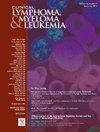原发性纵隔大 B 细胞淋巴瘤中枢神经系统复发的发生率:对中枢神经系统预防的影响。
IF 2.7
4区 医学
Q2 HEMATOLOGY
引用次数: 0
摘要
背景:原发性纵隔大B细胞淋巴瘤(PMBCL)是一种不常见的侵袭性B细胞非霍奇金淋巴瘤。PMBCL与结节性硬化的典型霍奇金淋巴瘤(cHL)有一些共同的临床和生物特征。中枢神经系统(CNS)复发在 cHL 中极为罕见。因此,可以预计PMBCL的中枢神经系统复发也不常见。在此,我们研究了接受标准化疗免疫疗法的PMBCL患者中枢神经系统复发的发生率:这项回顾性单中心分析包括在梅奥诊所就诊的 154 名新诊断的 PMBCL 患者。中枢神经系统复发率采用竞争风险模型计算,死亡被视为竞争风险:中位随访时间为39个月,3名患者出现中枢神经系统复发,且均伴有全身复发。整个队列中中枢神经系统复发的累积发生率为:1年1.43%(95% CI,0.3%-4.6%),2年和5年2.21%(95% CI,0.6%-5.8%)。对于未接受中枢神经系统预防治疗的患者(n = 131),1 年的发病率为 0.85%(95% CI,0.1%-4.2%),2 年和 5 年的发病率均为 1.80%(95% CI,0.3%-5.8%)。3名中枢神经系统复发的患者均接受了R-CHOP前线治疗;2名患者未接受任何中枢神经系统预防治疗,1名患者接受了鞘内中枢神经系统预防治疗:结论:PMBCL患者在接受标准化疗免疫疗法治疗后中枢神经系统复发的风险似乎很低,这表明常规中枢神经系统预防治疗并无必要。本文章由计算机程序翻译,如有差异,请以英文原文为准。
Incidence of Central Nervous System Relapse in Primary Mediastinal Large B-Cell Lymphoma: Implications for Central Nervous System Prophylaxis
Background
Primary mediastinal large B-cell lymphoma (PMBCL) is an uncommon type of aggressive B-cell non-Hodgkin lymphoma. PMBCL shares some clinical and biologic features with nodular sclerosis classic Hodgkin lymphoma (cHL). Central nervous system (CNS) relapse is exceedingly rare in cHL. Therefore, it may be expected that CNS relapse in PMBCL is also uncommon. Herein, we examined the incidence of CNS relapse in patients with PMBCL treated with standard chemoimmunotherapy.
Patients and Methods
This retrospective single center analysis included 154 patients with newly diagnosed PMBCL seen at Mayo Clinic. The CNS relapse rate was calculated using a competing risk model, with death considered as a competing risk.
Results
With a median follow-up of 39 months, 3 patients experienced CNS relapse, all associated with systemic relapse. The cumulative incidence of CNS relapse for the entire cohort was 1.43% (95% CI, 0.3%-4.6%) at 1 year and 2.21% (95% CI, 0.6%-5.8%) at both 2 and 5 years. For those who did not receive CNS prophylaxis (n = 131), the incidence was 0.85% (95% CI, 0.1%-4.2%) at 1 year and 1.80% (95% CI, 0.3%-5.8%) at both 2 and 5 years. All 3 patients who experienced CNS relapse had R-CHOP as frontline therapy; 2 patients did not receive any CNS prophylaxis, while 1 patient received intrathecal CNS prophylaxis.
Conclusion
The risk of CNS relapse in PMBCL appears to be very low after treatment with standard chemoimmunotherapy, suggesting routine CNS prophylaxis is not necessary.
求助全文
通过发布文献求助,成功后即可免费获取论文全文。
去求助
来源期刊

Clinical Lymphoma, Myeloma & Leukemia
ONCOLOGY-HEMATOLOGY
CiteScore
2.70
自引率
3.70%
发文量
1606
审稿时长
26 days
期刊介绍:
Clinical Lymphoma, Myeloma & Leukemia is a peer-reviewed monthly journal that publishes original articles describing various aspects of clinical and translational research of lymphoma, myeloma and leukemia. Clinical Lymphoma, Myeloma & Leukemia is devoted to articles on detection, diagnosis, prevention, and treatment of lymphoma, myeloma, leukemia and related disorders including macroglobulinemia, amyloidosis, and plasma-cell dyscrasias. The main emphasis is on recent scientific developments in all areas related to lymphoma, myeloma and leukemia. Specific areas of interest include clinical research and mechanistic approaches; drug sensitivity and resistance; gene and antisense therapy; pathology, markers, and prognostic indicators; chemoprevention strategies; multimodality therapy; and integration of various approaches.
 求助内容:
求助内容: 应助结果提醒方式:
应助结果提醒方式:


